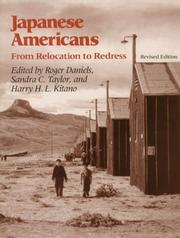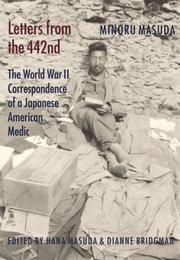| Listing 1 - 10 of 42 | << page >> |
Sort by
|
Book
ISBN: 1607324296 1607324288 160732752X 9781607324294 9781607324287 Year: 2016 Publisher: Boulder : Baltimore, Md. : University Press of Colorado, Project MUSE,
Abstract | Keywords | Export | Availability | Bookmark
 Loading...
Loading...Choose an application
- Reference Manager
- EndNote
- RefWorks (Direct export to RefWorks)
"Introduces a readable collection of portraits about a group of extraordinary men and women who made remarkable contributions in the arts, literature, law, sports, and other fields, and shed light on largely unknown aspects of Japanese American history"--Provided by publisher.
Japanese Americans --- History. --- Kibei Nisei --- Nisei --- Ethnology --- Japanese

ISBN: 0295801506 9780295801506 0295971177 9780295971179 Year: 1991 Publisher: Seattle, [Washington] ; London, [England] : University of Washington Press,
Abstract | Keywords | Export | Availability | Bookmark
 Loading...
Loading...Choose an application
- Reference Manager
- EndNote
- RefWorks (Direct export to RefWorks)
Japanese Americans --- Kibei Nisei --- Nisei --- Ethnology --- Japanese --- Reparations --- Evacuation and relocation, 1942-1945 --- Forced removal and internment, 1942-1945
Book
ISBN: 019027400X 0199813035 0199813043 1299848338 0199345325 9780199813049 9780199345328 9780199813032 Year: 2014 Publisher: New York : Oxford University Press,
Abstract | Keywords | Export | Availability | Bookmark
 Loading...
Loading...Choose an application
- Reference Manager
- EndNote
- RefWorks (Direct export to RefWorks)
Holehole bushi, folk songs of Japanese workers in Hawaii's plantations, describe the experiences of this particular group caught in the global movements of capital, empire, and labour during the late 19th and early 20th centuries. In this book author Franklin Odo situates over two hundred of these songs, in translation, in a hitherto largely unexplored historical context.
Sugar workers --- Immigrants --- Japanese Americans --- Folk songs, English --- English ballads and songs --- English folk songs --- Kibei Nisei --- Nisei --- Ethnology --- Japanese --- Emigrants --- Foreign-born population --- Foreign population --- Foreigners --- Migrants --- Persons --- Aliens --- Sugar trade --- History. --- History and criticism. --- Employees
Book
ISBN: 1607321661 9781607321668 9781457117374 1457117371 9781457117350 1457117355 9781607321651 1607321653 Year: 2012 Publisher: Boulder, Colo. : University Press of Colorado,
Abstract | Keywords | Export | Availability | Bookmark
 Loading...
Loading...Choose an application
- Reference Manager
- EndNote
- RefWorks (Direct export to RefWorks)
Immigrants --- Japanese Americans --- Emigrants --- Foreign-born population --- Foreign population --- Foreigners --- Migrants --- Persons --- Aliens --- Kibei Nisei --- Nisei --- Ethnology --- Japanese --- Civil rights --- Harada, Jukichi --- Harada, Ken, --- Harada, Jukichi, --- Family. --- Riverside (Calif.) --- City of Riverside (Calif.) --- Race relations --- History --- Indo, Ken,
Book
ISBN: 0299327884 0299327809 9780299327880 9780299327835 0299327833 9780299327804 Year: 2020 Publisher: Madison, Wisconsin : The University of Wisconsin Press,
Abstract | Keywords | Export | Availability | Bookmark
 Loading...
Loading...Choose an application
- Reference Manager
- EndNote
- RefWorks (Direct export to RefWorks)
Japanese Americans --- Forced removal and internment, 1942-1945 --- History. --- Higuchi, Shirley Ann --- Family. --- Heart Mountain Relocation Center (Wyo.) --- Kibei Nisei --- Nisei --- Ethnology --- Japanese --- Heart Mountain Relocation Camp (Wyo.) --- United States. --- Heart Mountain Internment Camp (Wyo.) --- Heart Mountain incarceration camp (Wyo.)
Book
ISBN: 1503628329 9781503628328 9781503614901 9781503628311 Year: 2021 Publisher: Stanford, California : Stanford University Press,
Abstract | Keywords | Export | Availability | Bookmark
 Loading...
Loading...Choose an application
- Reference Manager
- EndNote
- RefWorks (Direct export to RefWorks)
From the 1920s to the eve of the Pacific War in 1941, more than 50,000 young second-generation Japanese Americans (Nisei) embarked on transpacific journeys to the Japanese Empire, putting an ocean between themselves and pervasive anti-Asian racism in the American West. Born U.S. citizens but treated as unwelcome aliens, this contingent of Japanese Americans—one in four U.S.-born Nisei—came in search of better lives but instead encountered a world shaped by increasingly volatile relations between the U.S. and Japan. Based on transnational and bilingual research in the United States and Japan, Michael R. Jin recuperates the stories of this unique group of American emigrants at the crossroads of U.S. and Japanese empire. From the Jim Crow American West to the Japanese colonial frontiers in Asia, and from internment camps in America to Hiroshima on the eve of the atomic bombing, these individuals redefined ideas about home, identity, citizenship, and belonging as they encountered multiple social realities on both sides of the Pacific. Citizens, Immigrants, and the Stateless examines the deeply intertwined histories of Asian exclusion in the United States, Japanese colonialism in Asia, and volatile geopolitical changes in the Pacific world that converged in the lives of Japanese American migrants.
Japanese Americans --- Citizenship --- History --- Japan --- Colonies --- American West. --- Citizenship. --- Diaspora. --- Immigration. --- Japanese American. --- Kibei. --- Migration. --- Nisei. --- Pacific. --- World War II.

ISBN: 0295800445 9780295800448 9780295987453 0295987456 Year: 2008 Publisher: Seattle : ©2008 University of Washington Press,
Abstract | Keywords | Export | Availability | Bookmark
 Loading...
Loading...Choose an application
- Reference Manager
- EndNote
- RefWorks (Direct export to RefWorks)
This is the first collection of letters by a member of the legendary 442nd Combat Team, which served in Italy and France during World War II. Written to his wife by a medic serving with the segregated Japanese American unit, the letters describe a soldier's daily life.Minoru Masuda was born and raised in Seattle. In 1939 he earned a master's degree in pharmacology and married Hana Koriyama. Two years later the Japanese struck Pearl Harbor, and Min and Hana were imprisoned along with thousands of other Japanese Americans. When the Army recruited in the relocation camp, Masuda chose to serve in the 442nd. In April 1944 the unit was shipped overseas. They fought in Italy and in France, where they liberated Bruyeres and rescued a "lost battalion" that had been cut off by the Germans. After the German surrender on May 3, 1945, Masuda was among the last of the original volunteers to leave Europe; he arrived home on New Year's Eve 1945.Masuda's vivid and lively letters portray his surroundings, his daily activities, and the people he encountered. He describes Italian farmhouses, olive groves, and avenues of cypress trees; he writes of learning to play the ukulele with his "big, clumsy" fingers, and the nightly singing and bull sessions which continued throughout the war; he relates the plight of the Italians who scavenged the 442nd's garbage for food, and the mischief of French children who pelted the medics with snowballs.Excerpts from the 442nd daily medical log provide context for the letters, and Hana interposes brief recollections of her experiences. The letters are accompanied by snapshots, a drawing made in the field, and three maps drawn by Masuda.
Medical personnel --- Japanese Americans --- World War, 1939-1945 --- Health care personnel --- Health care professionals --- Health manpower --- Health personnel --- Health professions --- Health sciences personnel --- Health services personnel --- Healthcare professionals --- Medical manpower --- Professional employees --- Kibei Nisei --- Nisei --- Ethnology --- Japanese --- Participation, Japanese American. --- Masuda, Minoru, --- United States. --- U.S. Army --- US Army
Book
ISBN: 029580629X 9780295806297 9780295995151 0295995157 Year: 2015 Publisher: Seattle, [Washington] ; London, [England] : University of Washington Press,
Abstract | Keywords | Export | Availability | Bookmark
 Loading...
Loading...Choose an application
- Reference Manager
- EndNote
- RefWorks (Direct export to RefWorks)
Fred Korematsu’s decision to resist F.D.R.’s Executive Order 9066, which provided authority for the internment of Japanese Americans during World War II, was initially the case of a young man following his heart: he wanted to remain in California with his white fiancée. However, he quickly came to realize that it was more than just a personal choice; it was a matter of basic human rights. After refusing to leave for incarceration when ordered, Korematsu was eventually arrested and convicted of a federal crime before being sent to the internment camp at Topaz, Utah.He appealed his conviction to the Supreme Court, which, in one of the most infamous cases in American legal history, upheld the wartime orders. Forty years later, in the early 1980s, a team of young attorneys resurrected Korematsu’s case. This time, Korematsu was victorious, and his conviction was overturned, helping to pave the way for Japanese American redress. Lorraine Bannai, who was a young attorney on that legal team, combines insider knowledge of the case with extensive archival research, personal letters, and unprecedented access to Korematsu his family, and close friends. She uncovers the inspiring story of a humble, soft-spoken man who fought tirelessly against human rights abuses long after he was exonerated. In 1998, President Bill Clinton awarded Korematsu the Presidential Medal of Freedom.
Japanese Americans --- Kibei Nisei --- Nisei --- Ethnology --- Japanese --- Evacuation and relocation --- Civil rights --- History --- Korematsu, Fred, --- Korematsu, Toyosaburo, --- Korematsu, Toy, --- Forced removal and internment, 1942-1945. --- Forced removal of Japanese Americans, 1942-1945 --- Internment of Japanese Americans, 1942-1945 --- World War, 1939-1945 --- Evacuation and relocation, 1942-1945 --- Forced removal of civilians --- Evacuation and relocation, 1942-1945. --- Trials, litigation, etc.

ISBN: 0429235666 0203819489 1299285856 1136743553 9780203819487 0415932343 9780415932349 0415932351 9780415932356 0815339461 9780815339465 081533947X 9780815339472 9781136743559 9781136743504 1136743502 9781136743542 1136743545 Year: 2002 Publisher: New York : RoutledgeFalmer,
Abstract | Keywords | Export | Availability | Bookmark
 Loading...
Loading...Choose an application
- Reference Manager
- EndNote
- RefWorks (Direct export to RefWorks)
Wherever I Go I'll Always Be a Loyal American is the story of how the Seattle public schools responded to the news of its Japanese American (Nisei) students' internment upon the signing of Executive Order 9066 by President Franklin D. Roosevelt on February 14, 1942. Drawing upon previously untapped letters and compositions written by the students themselves during the time in which the bombing of Pearl Harbor and the internment order took place, Pak explores how the schools and their students attempted to cope with evident contradiction and dissonance in democracy and citizenship. E
Japanese Americans --- World War, 1939-1945 --- European War, 1939-1945 --- Second World War, 1939-1945 --- World War 2, 1939-1945 --- World War II, 1939-1945 --- World War Two, 1939-1945 --- WW II (World War, 1939-1945) --- WWII (World War, 1939-1945) --- History, Modern --- Kibei Nisei --- Nisei --- Ethnology --- Japanese --- Education --- Education (Primary)
Book
ISBN: 1479834971 1479821780 Year: 2016 Publisher: New York, NY : New York University Press,
Abstract | Keywords | Export | Availability | Bookmark
 Loading...
Loading...Choose an application
- Reference Manager
- EndNote
- RefWorks (Direct export to RefWorks)
Traces the contemporary ethnic experiences of Japanese AmericansAs one of the oldest groups of Asian Americans in the United States, most Japanese Americans are culturally assimilated and well-integrated in mainstream American society. However, they continue to be racialized as culturally “Japanese” foreigners simply because of their Asian appearance in a multicultural America where racial minorities are expected to remain ethnically distinct. Different generations of Japanese Americans have responded to such pressures in ways that range from demands that their racial citizenship as bona fide Americans be recognized to a desire to maintain or recover their ethnic heritage and reconnect with their ancestral homeland. In Japanese American Ethnicity, Takeyuki Tsuda explores the contemporary ethnic experiences of Japanese Americans from the second to the fourth generations and the extent to which they remain connected to their ancestral cultural heritage. He also places Japanese Americans in transnational and diasporic context and analyzes the performance of ethnic heritage through the example of taiko drumming ensembles. Drawing on extensive fieldwork with Japanese Americans in San Diego and Phoenix, Tsuda argues that the ethnicity of immigrant-descent minorities does not simply follow a linear trajectory. Increasing cultural assimilation does not always erode the significance of ethnic heritage and identity over the generations. Instead, each new generation of Japanese Americans has negotiated its own ethnic positionality in different ways. Young Japanese Americans today are reviving their cultural heritage and embracing its salience in their daily lives more than the previous generations. This book demonstrates how culturally assimilated minorities can simultaneously maintain their ancestral cultures or even actively recover their lost ethnic heritage.
Japanese Americans --- Taiko (Drum ensemble) --- Children of immigrants --- First generation children --- Immigrants' children --- Second generation children --- Immigrants --- Percussion ensembles --- Kibei Nisei --- Nisei --- Ethnology --- Japanese --- Ethnic identity. --- Cultural assimilation. --- Social life and customs. --- Racial identity. --- History. --- Race identity --- United States --- Japan --- Ethnic relations. --- Race relations. --- Emigration and immigration. --- Immigration --- Race question
| Listing 1 - 10 of 42 | << page >> |
Sort by
|

 Search
Search Feedback
Feedback About UniCat
About UniCat  Help
Help News
News